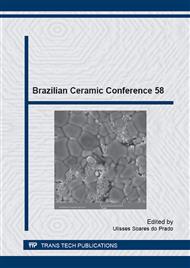p.199
p.205
p.213
p.218
p.225
p.231
p.239
p.244
p.250
Electrochemical Study of Ceramics Based on Niobium Oxide over Aluminum Alloy AA 3003
Abstract:
Corrosion is an undesirable action which can occur in metals. To minimize this problem, there are several types of coat to the metal surface being researched in an attempt to retard the oxidation processes. In this work, the deposition of a new ceramic coating based on niobium oxide over aluminum alloy AA 3003 was studied in order to obtaining a corrosion resistant and less polluting film. It was utilized the experimental planning to optimize the deposition of ceramics, and it was performed electrochemical tests, scanning electron microscopy and dispersive energy spectroscopy to evaluate these films. The ceramic coating based on niobium oxide obtained presented itself as an effective corrosion inhibitor for aluminum alloy AA 3003.
Info:
Periodical:
Pages:
225-230
Citation:
Online since:
June 2015
Keywords:
Price:
Сopyright:
© 2015 Trans Tech Publications Ltd. All Rights Reserved
Share:
Citation:


